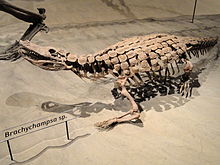Brachychampsa
|
Brachychampsa Temporal range: 83.5–63.3 Ma Late Cretaceous - Early Paleocene |
|
|---|---|
 |
|
| Brachychampsa sp. | |
| Scientific classification | |
| Kingdom: | Animalia |
| Phylum: | Chordata |
| Class: | Reptilia |
| Order: | Crocodilia |
| Clade: | Globidonta |
| Genus: |
†Brachychampsa Gilmore, 1911 |
| Species | |
Brachychampsa is an extinct genus of alligatoroid. Specimens have been found from New Mexico, Colorado, Wyoming,Montana,North and South Dakota,New Jersey, and Saskatchewan. One specimen has been found from the Darbasa Formation of Kazakhstan, although the species status is indeterminant for the fossil. The genus first appeared during the late Campanian stage of the Late Cretaceous (Judithian North American stage) and became extinct during the early Danian stage of the Paleocene (Puercan North American stage), a few million years after the Cretaceous–Paleogene extinction event. Brachychampsa is distinguished by an enlarged fourth maxillary tooth in the upper jaw.
Brachychampsa's position within the superfamily Alligatoroidea has undergone many revisions since it was first named. Originally it was placed within the family Alligatoridae, and was later refined to the subfamily Alligatorinae in 1964, only to be placed outside both Alligatorinae and Alligatoridae (but still within Alligatoroidea) in 1994.
The type species of Brachychampsa is B. montana, first discovered from the Hell Creek Formation of Montana and described by Charles W. Gilmore in a paper in 1911. In that same paper, Gilmore recombined Bottosaurus perrugosus as a new species of Brachychampsa, called B. perrugosus. The holotype specimen of B. perrugosus went missing as the paper was being written, but it was later rediscovered and soon afterward designated as a nomen dubium due to a lack of diagnostic features that distinguish it from other alligatorids discovered since the paper was published. Another species from the Allison Member of the Menefee Formation of the San Juan Basin, B. sealeyi, was discovered in 1996, but was later argued to be synonymous with B. montana by interpreting it as an immature specimen of the latter species. However, other studies claim that some of the variation seen between the two species, such as the orientation of the maxillary tooth row, may not be ontogenic, thus making B. sealeyi a valid taxon.
...
Wikipedia
